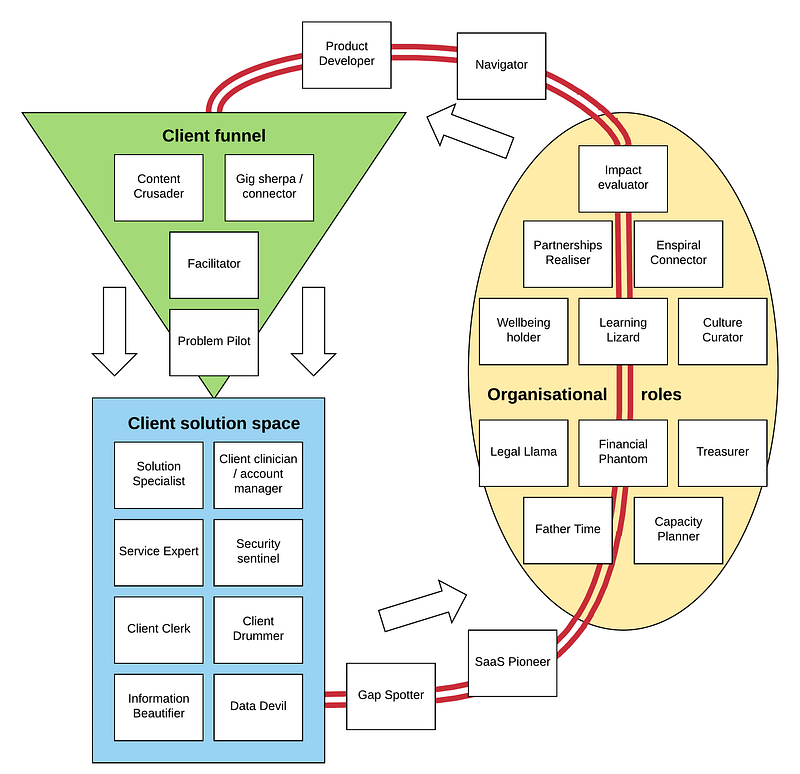By Rupert Snook and originally published in Enspiral Tales on medium.com
Hi! Rupert here from Optimi. We were lucky to work with a wonderful self-management consultant recently, named Susan Basterfield.
Susan facilitated a workshop which helped us to build a coherent picture of our work, and helped us to stay connected to each other in accountability to that work. So now we don’t need a dedicated manager to hold us accountable. What an awesome outcome!
Perhaps you’re interested in self management too. Maybe you’ve got to the point of knowing what your work is, but you’re struggling with the accountability part. I’d like to share the story of Susan’s workshop with you, so you can see how we got past the accountability challenge. Let’s talk it through from the beginning, starting from….
#1. Define the work (as roles)
Susan asked us to imagine the work we did within Optimi as a series of roles. We took some time to brainstorm, writing up a title, purpose and set of accountabilities for each role that we could imagine.
Here’s an example of a role we defined.
- Role title: Solution specialist
- Role purpose: Take known client problems and generate valuable solutions
- Role accountabilities:
* Understand when a client problem is fully defined and ready to be solved
* Help solution brainstorms to be creative
* Prioritise different solution options
* Form and check hypotheses to validate work that we’re doing
* implement solutions
This is just one of 27 roles that we brainstormed and shared with each other, to help define the work that we do within the Optimi team.
#2. Connect the roles together
Once we’d come up with roles to define our work, the next step was to find the connections between our roles. After lots of clustering and shuffling and theming, we came up with a high level picture.

#3. Self nominate for accountability
Having formed a shared understanding of the roles that kept our collective heart beating, it was time to get down to the nitty gritty. Who was going to be accountable for each role? We started self-nominating, selecting the roles we thought our skills were well suited to.
Some roles were popular, and ended up with multiple owners. Other roles were a bit lonely, with no one feeling well suited. After some negotiation, all but two roles had at least one person accountable to them. We decided that we might hire someone in the future who had potential to be accountable to our two ownerless roles.
Interlude: accountability is hard!
By the end of our workshop with Susan, we’d defined our roles and traced their accountability. Woohoo! But the work wasn’t finished there. We needed to figure out how we were going to make sure those roles kept getting taken care of as we moved forward.
This is a real challenge. I’ve seen teams do the fun exercise of defining their roles, generating lots of energy. But I’ve also seen some teams never reap the benefits of knowing their roles. Sometimes, the initial energy dissipates, and the roles fall into disrepair.
#4. Build an accountability rhythm
Luckily at Optimi, maintenance is our middle name. To maintain our energy around roles, we came up with a lightweight meeting rhythm that’s working well for us. I call it “accountability questions”, because it helps us to maintain accountability for our roles through sharing questions. Here’s how we set it up:
- We had a shared discussion around what success looks like for each role.
- For each role, we came up with an “accountability question” or two that we’d like to be asked each month. Each question reflects the definition of success for the role.
- We refined our “accountability questions” so that most of them can be answered with a simple yes or no. This is important, because it encourages honest reflection! No maybes or sort-ofs. I find accountability works really well when I can’t hide behind a maybe.
- We decided to meet each month, to ask each other our questions. Once we’ve answered the questions, we then take the opportunity to set intentions for our roles for the following month.
Here’s an example of some questions that I answer each month, for a role called “Learning Lizard”.
Have you done your best to enable every Optimi team member to have well-formed learning goals?
Do you know how each team member is progressing on their goals?
It feels great to answer those questions with an honest yes or no!
Let’s look into how the questions reinforce accountability. A conversation might sound something like this:
Charley: Rupert, here’s a question that you’ve written for your Learning Lizard role. Have you done your best to enable every Optimi team member to have well-formed learning goals?
Rupert: Hmmm….. (pauses to think about it)…. No.
Charley: Ok. Do you have any intentions for the next month?
Rupert: I think I need to run a goal-setting session for the team.
Malcolm: My navigator role can help with that!
Rupert: Great, I’ll set up the session.
Credit where credit is due: I borrowed the technique of using yes/no questions for accountability. It’s from a personal development tool called the Daily Questions Process.
How we made self-management stick
Let’s come back full circle to the title of this piece. It’s all about self-management. Self-managing by knowing what the important roles are in our team. Self-managing by helping each other to be accountable to those roles, through our “accountability questions”. And self-managing by using those questions to set our future intentions together!
So that’s what self-management looks like for us. I hope it’s been helpful or interesting for you to read our take on it. Now I’d love to hear what self-management looks like (or could look like) for you!
— Rupert from Optimi
Republished with permission of the author.
Featured Image/graphic link added by Enlivening Edge Magazine.




